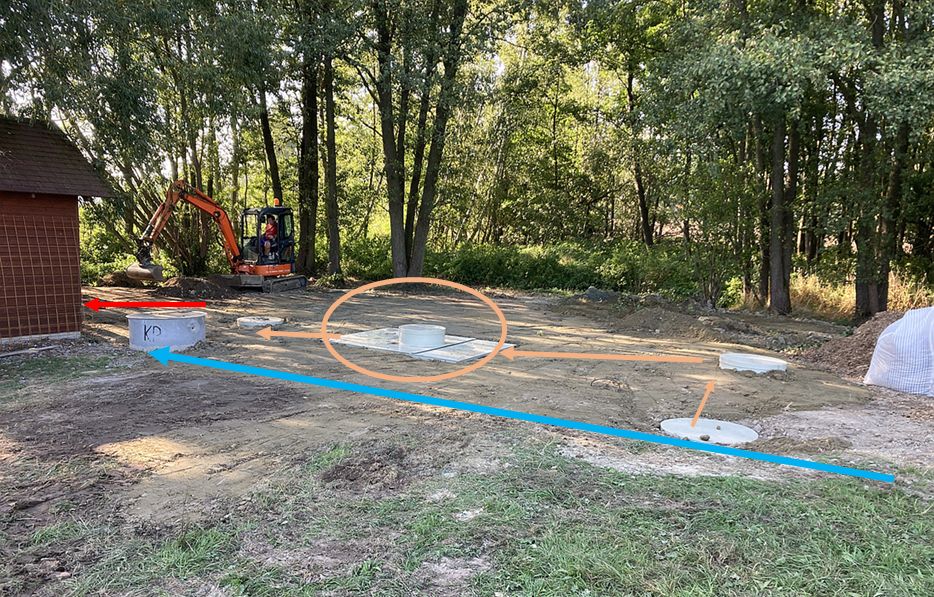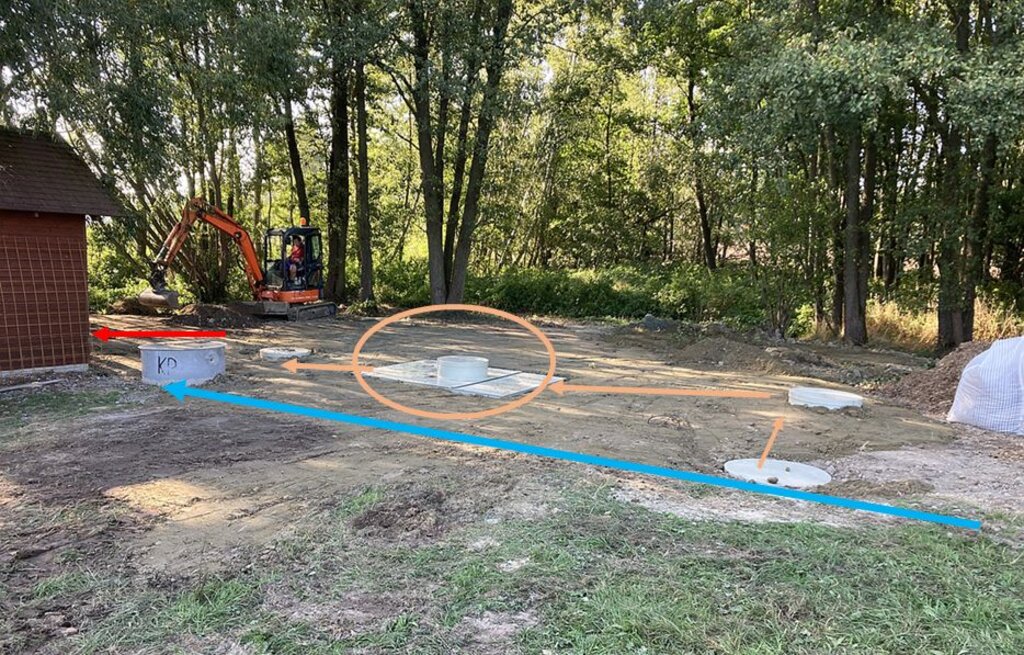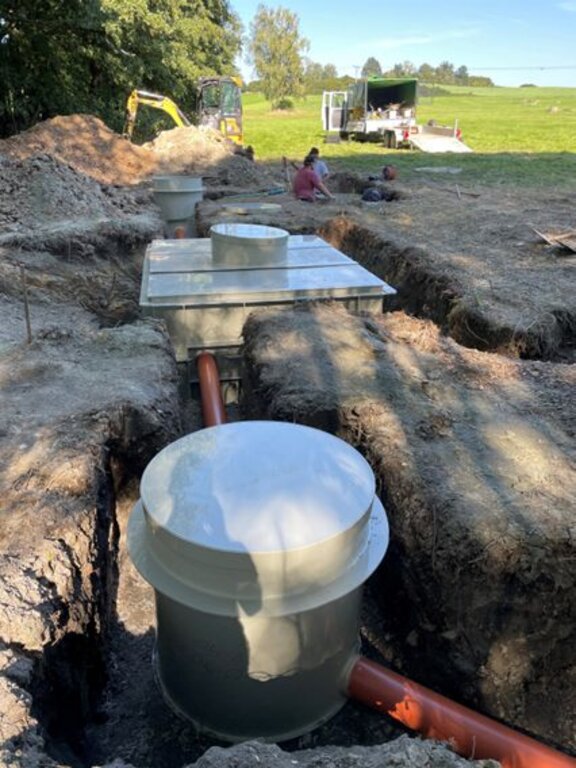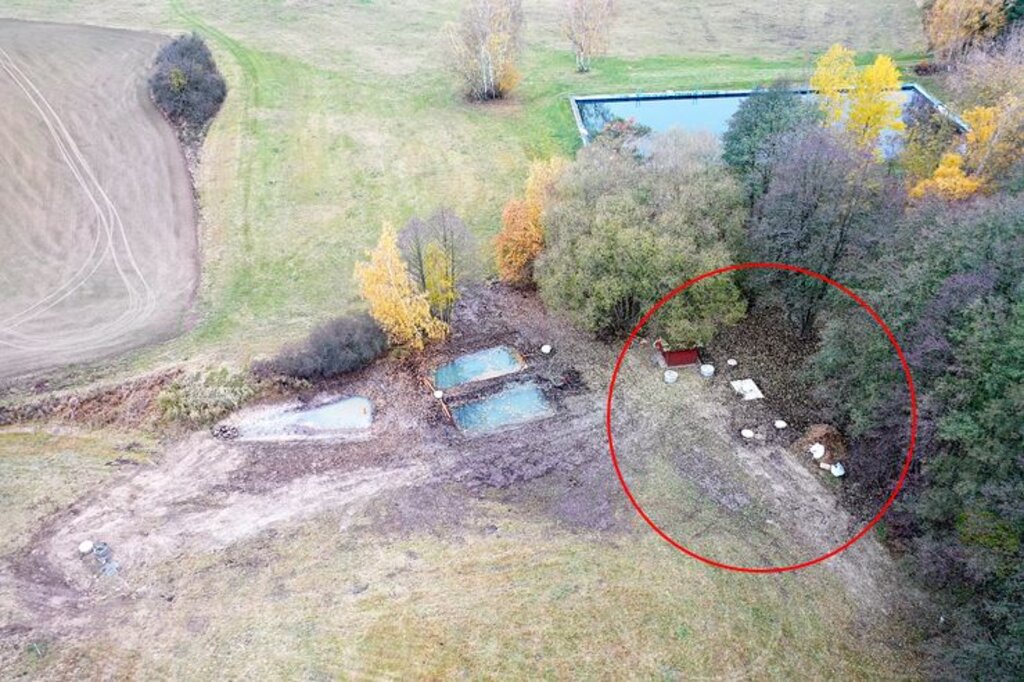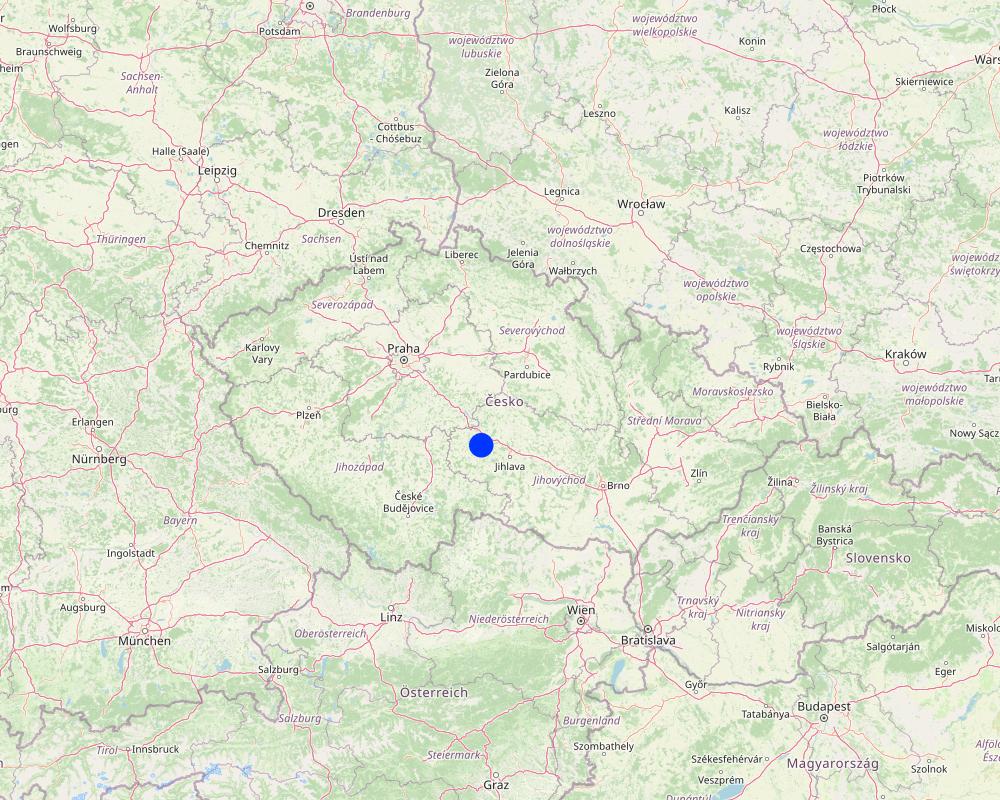Drainage Biofilter [捷克共和国]
- 创建:
- 更新:
- 编制者: Antonín Zajíček
- 编辑者: –
- 审查者: William Critchley, Rima Mekdaschi Studer
Drenážní biofiltr
technologies_6259 - 捷克共和国
查看章节
全部展开 全部收起1. 一般信息
1.2 参与该技术评估和文件编制的资源人员和机构的联系方式
有助于对技术进行记录/评估的项目名称(如相关)
OPtimal strategies to retAIN and re-use water and nutrients in small agricultural catchments across different soil-climatic regions in Europe (OPTAIN)有助于对技术进行记录/评估的项目名称(如相关)
Approaches for design and realization of complex effective measures for tile drained agricultural catchments by land consolidations (QK21010341)有助于对技术进行记录/评估的机构名称(如相关)
Research Institute for Soil and Water Conservation (VUMOP) - 捷克共和国1.3 关于使用通过WOCAT记录的数据的条件
编制者和关键资源人员接受有关使用通过WOCAT记录数据的条件。:
是
1.4 所述技术的可持续性声明
这里所描述的技术在土地退化方面是否存在问题,导致无法被认为是一种可持续的土地管理技术?:
否
注释:
The advantage of the drainage biofilter is that it occupies only a relatively small area and only minimally impedes soil cultivation
1.5 参考关于SLM方法(使用WOCAT记录的SLM方法)的调查问卷
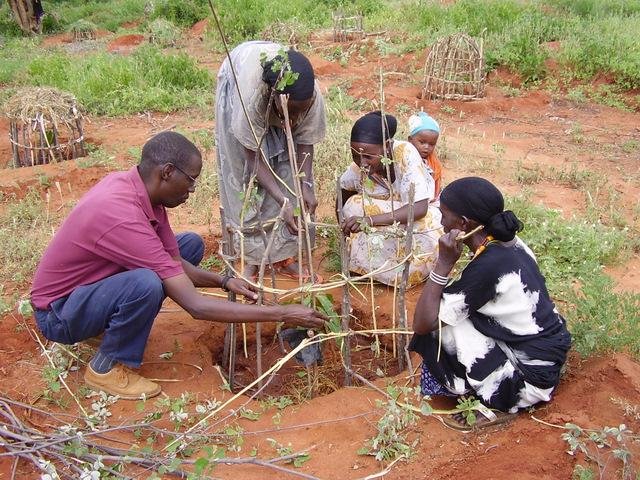
Catchment Approach [肯尼亚]
A focused approach to integrated land and water management, including soil and water conservation, where the active participation of the villagers - often organised through common interest groups - is central.
- 编制者: James Gatero Njuki

Applied research and knowledge transfer [摩洛哥]
Innovative, cross-disciplinary community-based approach for development and transfer of no-till technology at the farm level.
- 编制者: Rachid Mrabet
2. SLM技术的说明
2.1 技术简介
技术定义:
Biofilters or “bioreactors” connected to agricultural tile drains are relatively inexpensive and space-saving measures with considerable potential to improve the quality of drainage water.
2.2 技术的详细说明
说明:
A biofilter or “bioreactor” is a relatively small installation used to break down pollutants from drainage water. Its basic function is to allow the passage of drainage water, contaminated with nutrients and pesticides, through a container with pollutant-reducing agents. Bioreactors are usually located at the bottom of agricultural drainage structures on the drains or in connection with drainage outlets. Ideally, the biofilter is located on a site that is no longer part of the cultivated land or is under permanent grassland.
In principle, two biofilter solutions are possible. In the case of low and regular drainage flows, the drainage section is directly replaced by a biofilter. With higher flows and in the case of rapid response of the drainage structure to rainfall-runoff episodes, the biofilter is placed parallel to the outlet drain or is located under the drainage outlet (if ambient conditions allow). Such a design includes a distribution structure (preferably located in a drainage manhole) and a drainage pipe to allow safe bypassing of a portion of the elevated drainage outlet, to maintain the residence time of the water in the biofilter and thus its corresponding efficiency.
The biofilter may be designed as closed or open. A closed biofilter is completely buried and normal tillage can take place. An open biofilter lacks the advantage of an undisturbed terrain but has the advantage of benefitting from plants that enhance the purification of drainage water by bacteria living on their roots.
The installation always consists of a bed or container in which the reducing agent is enclosed, ensuring the isolation of the agent from the surrounding soil and water. In the case of a smaller sized closed biofilter, a plastic container can be used, while in the case of a larger or open design, plastic film can be used as a bed. Various materials can be used as biofilter fillings, or substrates, both individually and in combination. In most cases, the reducing agent is carbonaceous, with denitrification mediated by chemo-organotrophic bacteria.
In terms of N-NO3 removal, the most effective are wood chips, which have a high hydraulic conductivity and a C:N ratio of 30:1 to 300:1. In particular, chips from poplar, pine and larch are suitable. For the removal of pesticides or biopharmaceuticals, then biochar (biochar) and lignite are suitable as natural and readily available materials. A combination of materials can also be used. For example, the addition of biochar to the wood chips will increase the efficiency of the bioreactor in degrading pesticides, or the charge can be combined with an inorganic substrate (sand, vermiculite), which is added to prevent undesirable settling, reduce hydraulic conductivity and at the same time mechanically purify the drainage water.
2.3 技术照片
2.5 已应用该技术的、本评估所涵盖的国家/地区/地点
国家:
捷克共和国
区域/州/省:
Vysočina region (Highlands Region)
有关地点的进一步说明:
Černičí, Dehtáře
具体说明该技术的分布:
- 适用于特定场所/集中在较小区域
技术现场是否位于永久保护区?:
否
Map
×2.6 实施日期
如果不知道确切的年份,请说明大概的日期:
- 不到10年前(最近)
2.7 技术介绍
详细说明该技术是如何引入的:
- 在实验/研究期间
- 通过项目/外部干预
注释(项目类型等):
Several biofilters have already been implemented as part of research projects, and the development of a standardized, efficient and easy-to-implement solution is currently underway.
3. SLM技术的分类
3.1 该技术的主要目的
- 结合其他技术保护流域/下游区域
- 保持/提高生物多样性
- reduce diffusive agricultural pollution
3.2 应用该技术的当前土地利用类型
同一土地单元内混合使用的土地::
否

农田
- 多年一作(非木材)
多年生(非木质)作物 - 指定作物:
- 饲料作物 - 草
每年的生长季节数:
- 1
采用间作制度了吗?:
否
采用轮作制度了吗?:
否

水道、水体、湿地
- 排水管道、水道
3.3 由于技术的实施,土地使用是否发生了变化?
由于技术的实施,土地使用是否发生了变化?:
- 是(请在技术实施前填写以下有关土地利用的问题)

农田
- 一年一作
年作 - 具体指明作物:
- 谷类 - 大麦
- 谷物类 - 玉米
- 谷类 - 小麦(冬季)
- 油料作物 - 向日葵、菜籽、其他
- 根/块茎作物 - 土豆
采用间作制度了吗?:
是
如果是,说明哪些作物是间作的:
In some seasons, spring cereal mix, legume-cereal mix or undersown clover is used as an intercrop
采用轮作制度了吗?:
是
如果是,请具体说明:
five-years or seven-years crop rotation containinng winter cereals, spring cereals, potatoes, red clover, oil seed rape and maize
3.4 供水
该技术所应用土地的供水:
- 雨养
3.5 该技术所属的SLM组
- 地表水管理(泉、河、湖、海)
- 地下水管理
3.6 包含该技术的可持续土地管理措施

植物措施
- V2:草和多年生草本植物

结构措施
- S11:其它
3.7 该技术强调的主要土地退化类型

水质恶化
- Hp:地表水水质下降
- Hq:地下水水质下降
3.8 防止、减少或恢复土地退化
具体数量名该技术与土地退化有关的目标:
- 不适用
注释:
This measure is primarily aimed at improving water quality.
4. 技术规范、实施活动、投入和成本
4.1 该技术的技术图纸
技术规范(与技术图纸相关):
The drawing shows a closed biofilter/bioreactor system, which is built as a bypass of the existing drainage pipe. The measure is looped at the bottom of the drainage system to approximate the recipient.
This system consists mainly of the following features:
1) Drainage water inlet - existing drainage pipe - tile drains
2) Flow control facillity, which is built on top of the existing drainage pipe. The main line structure was excavated, the original ceramic pipe was replaced with a plastic PP pipe and a manhole with an embedded baffle was inserted to allow the water to rise to the required level and subsequently overflow the excess water over the overflow edge. A control element is placed in the manhole to regulate the flow of water into the system.
3) The existing drain, which, once the measures are constructed, serves as a bypass for excess runoff during spring thaw or significant rainfall-runoff episodes.
4) Inflow to the biofilter in the form of a newly constructed pipe.
5) Bed of biofilter - a hardened bed to prevent destruction of the biofilter by shallow groundwater levels and a plastic container for the actual biofilter fill.
6) Biofilter fill. I.n this case a mixture of vermiculite, wood chips and biochar, alternatively wood chips themselves or other materials can be used
7) Purified water outlet from the biofilter
8) Flow control facility, built in drainage manhole, purified water is returned to the existing drainage pipe
9) Drainage outlet
作者:
Research Institute for Soil and Water Conservation
日期:
01/02/2023
4.2 有关投入和成本计算的一般信息
具体说明成本和投入是如何计算的:
- 每个技术单元
指定单位:
measure - one system of closed biofilter/bioreactor
其它/国家货币(具体说明):
EUR
如相关,注明美元与当地货币的汇率(例如1美元=79.9巴西雷亚尔):1美元=:
0.92
注明雇用劳工的每日平均工资成本:
150
4.3 技术建立活动
| 活动 | 时间(季度) | |
|---|---|---|
| 1. | Selecting proper place for the measure | Before implementation |
| 2. | Obtaining the consent of the owners and users of the affected land | Before implementation |
| 3. | Project documentation | Before implementation |
| 4. | Water management office permisiond and building permission | Before implementation |
| 5. | Excavation works | Drier period, ideally at the end of the growing season |
| 6. | Biofilter construction | Drier period, ideally at the end of the growing season |
| 7. | Filling the biofilter with substrates | Drier period, ideally at the end of the growing season |
4.4 技术建立所需要的费用和投入
| 对投入进行具体说明 | 单位 | 数量 | 单位成本 | 每项投入的总成本 | 土地使用者承担的成本% | |
|---|---|---|---|---|---|---|
| 劳动力 | Project/design | person-days | 5.0 | 200.0 | 1000.0 | 100.0 |
| 劳动力 | Engineering | person-days | 10.0 | 200.0 | 2000.0 | 100.0 |
| 劳动力 | Implementation of the measure | person-days | 6.0 | 150.0 | 900.0 | 100.0 |
| 设备 | Tansport of material | machine-days | 5.0 | 150.0 | 750.0 | 100.0 |
| 设备 | Excavation works | machine-days | 3.0 | 220.0 | 660.0 | 100.0 |
| 植物材料 | grasss seeding | kg | 10.0 | 8.0 | 80.0 | 100.0 |
| 施工材料 | Distribution object (manhole) | piece | 2.0 | 2200.0 | 4400.0 | 100.0 |
| 施工材料 | Container for filling the biofilter | piece | 1.0 | 2400.0 | 2400.0 | 100.0 |
| 施工材料 | Sorbents (vermukulit, biochar, woodchips) | m3 | 3.0 | 440.0 | 1320.0 | 100.0 |
| 施工材料 | drainage pipes and other material | m | 20.0 | 2.0 | 40.0 | 100.0 |
| 技术建立所需总成本 | 13550.0 | |||||
| 技术建立总成本,美元 | 14728.26 | |||||
如果土地使用者负担的费用少于100%,请注明由谁负担其余费用:
co-financing from public sources
注释:
Under certain conditions, owners and users of land, regardless of their legal form, municipalities and other public entities may apply for a subsidy for the implementation of this measure, which is provided by the Ministry of the Environment of the Czech Republic
The subsidy is up to 100 % of the total eligible expenditure, the minimum eligible direct implementation expenditure per project is set at CZK 250 000 ( 10 000 EUR), excluding VAT.
4.5 维护/经常性活动
| 活动 | 时间/频率 | |
|---|---|---|
| 1. | Exchange of reducing agent in biofilter | every 5 - 10 years |
| 2. | Cutting the grass aroun the measure | twice a year |
| 3. | Checking and maintenance/repairs | once a year |
4.6 维护/经常性活动所需要的费用和投入(每年)
| 对投入进行具体说明 | 单位 | 数量 | 单位成本 | 每项投入的总成本 | 土地使用者承担的成本% | |
|---|---|---|---|---|---|---|
| 劳动力 | grass chopper | machine days | 1.0 | 100.0 | 100.0 | 100.0 |
| 植物材料 | grasss seed | kg | 10.0 | 8.0 | 80.0 | 100.0 |
| 技术维护所需总成本 | 180.0 | |||||
| 技术维护总成本,美元 | 195.65 | |||||
注释:
It is necessary to replace the sorbent once every 5 years to once every 10 years. The price of sorbents (vermiculite, biochar, woodchips) EUR 1320 for ca 3 cubic meters needed. The price for transportation and switching of old and new sorbents is ca EUR 300.
4.7 影响成本的最重要因素
描述影响成本的最决定性因素:
The price of this measure is mostly influenced by its dimensioning for a certain water residence time of the drainage runoff (the above described example is dimensioned for a delay period of about 12 hours at a maximum drainage flow of 0.5 l/s). Another factor is the price of sorbents, where biochar and vermiculite in particular are quite expensive (approximately 250 EUR/m3). Alternatively, woodchips can be used (80 EUR/m3). The price can also be reduced by a simpler construction of the biofilter bed. The minimum price for this measure is estimated at EUR 3 200.
5. 自然和人文环境
5.1 气候
年降雨量
- < 250毫米
- 251-500毫米
- 501-750毫米
- 751-1,000毫米
- 1,001-1,500毫米
- 1,501-2,000毫米
- 2,001-3,000毫米
- 3,001-4,000毫米
- > 4,000毫米
指定年平均降雨量(若已知),单位为mm:
666.00
有关降雨的规范/注释:
Total precipitation during the vegetation
period ranges between 350 and 450 mm, and in the
winter months between 250 and 300 mm, with a total annual
average of 666 mm.
注明所考虑的参考气象站名称:
Košetice, own measurement
农业气候带
- 半湿润
mean average temperature 7,9 °C
5.2 地形
平均坡度:
- 水平(0-2%)
- 缓降(3-5%)
- 平缓(6-10%)
- 滚坡(11-15%)
- 崎岖(16-30%)
- 陡峭(31-60%)
- 非常陡峭(>60%)
地形:
- 高原/平原
- 山脊
- 山坡
- 山地斜坡
- 麓坡
- 谷底
垂直分布带:
- 0-100 m a.s.l.
- 101-500 m a.s.l.
- 501-1,000 m a.s.l.
- 1,001-1,500 m a.s.l.
- 1,501-2,000 m a.s.l.
- 2,001-2,500 m a.s.l.
- 2,501-3,000 m a.s.l.
- 3,001-4,000 m a.s.l.
- > 4,000 m a.s.l.
说明该技术是否专门应用于:
- 凸形情况
关于地形的注释和进一步规范:
The altitude varies between 549.8 and 497 m asl., The substrate is formed by partially
migmatized paragneiss in various degrees of degradation.
Quaternary sediments are represented by slope sands and
loams reaching 1–2 m thickness.
5.3 土壤
平均土层深度:
- 非常浅(0-20厘米)
- 浅(21-50厘米)
- 中等深度(51-80厘米)
- 深(81-120厘米)
- 非常深(> 120厘米)
土壤质地(表土):
- 中粒(壤土、粉土)
土壤质地(地表以下> 20厘米):
- 中粒(壤土、粉土)
- 细粒/重质(粘土)
表土有机质:
- 中(1-3%)
如有可能,附上完整的土壤描述或具体说明可用的信息,例如土壤类型、土壤酸碱度、阳离子交换能力、氮、盐度等。:
The representation of soils
(according to the World Reference Base for Soil Resources
2006) is variable, with Gleyed Cambisols, Gleysols, and
sporadically Histosols. In the recharge area, the soil cover is
more homogenous, with prevailing Modal, Ranker and
Arenic Cambisols.
5.4 水资源可用性和质量
地下水位表:
< 5米
地表水的可用性:
好
水质(未处理):
仅供农业使用(灌溉)
水质请参考::
地下水和地表水
水的盐度有问题吗?:
否
该区域正在发生洪水吗?:
否
关于水质和水量的注释和进一步规范:
Water quality is threatened by non-point source (agricultural) pollution, in particular by increased leaching of nitrate nitrogen and pesticides and their metabolites
5.5 生物多样性
物种多样性:
- 中等
栖息地多样性:
- 中等
5.6 应用该技术的土地使用者的特征
定栖或游牧:
- 定栖的
生产系统的市场定位:
- 商业/市场
非农收入:
- 低于全部收入的10%
相对财富水平:
- 平均水平
- 丰富
个人或集体:
- 合作社
- 员工(公司、政府)
机械化水平:
- 机械化/电动
性别:
- 女人
- 男人
土地使用者的年龄:
- 青年人
- 中年人
- 老年人
5.7 应用该技术的土地使用者使用的平均土地面积
- < 0.5 公顷
- 0.5-1 公顷
- 1-2 公顷
- 2-5公顷
- 5-15公顷
- 15-50公顷
- 50-100公顷
- 100-500公顷
- 500-1,000公顷
- 1,000-10,000公顷
- > 10,000公顷
这被认为是小规模、中规模还是大规模的(参照当地实际情况)?:
- 中等规模的
注释:
The Czech Republic is characterised by a significant size of agricultural holdings. During the socialist era (1948-1989), large agricultural cooperatives were established. Today, most agricultural land is still farmed by similar enterprises, whether in the form of cooperatives, limited liability companies or joint stock companies.
5.8 土地所有权、土地使用权和水使用权
土地所有权:
- 公司
- 社区/村庄
土地使用权:
- 租赁
- 个人
用水权:
- 自由进入(无组织)
土地使用权是否基于传统的法律制度?:
否
5.9 进入服务和基础设施的通道
健康:
- 贫瘠
- 适度的
- 好
教育:
- 贫瘠
- 适度的
- 好
技术援助:
- 贫瘠
- 适度的
- 好
就业(例如非农):
- 贫瘠
- 适度的
- 好
市场:
- 贫瘠
- 适度的
- 好
能源:
- 贫瘠
- 适度的
- 好
道路和交通:
- 贫瘠
- 适度的
- 好
饮用水和卫生设施:
- 贫瘠
- 适度的
- 好
金融服务:
- 贫瘠
- 适度的
- 好
6. 影响和结论性说明
6.1 该技术的现场影响
生态影响
水循环/径流
水量
注释/具体说明:
Slowing of the drainage runoff will be noticeable especially during normal and lower discharges
水质
注释/具体说明:
The effects of the measures are particularly positive in terms of reducing nutrient (nitrogen, phosphorus) and pesticide concentrations
6.2 该技术的场外影响已经显现
地下水/河流污染
注释/具体说明:
The effect of biofilter-type measures is particularly pronounced in small intensively drained agricultural catchments where much of the runoff (and pollution) comes from drainage waters
6.3 技术对渐变气候以及与气候相关的极端情况/灾害的暴露和敏感性(土地使用者认为的极端情况/灾害)
其他气候相关的后果
其他气候相关的后果
| 该技术是如何应对的? | |
|---|---|
| Irregular rainfall distribution and increasing number of runoff episodes | 适度 |
注释:
A sudden increase in drainage flow during a rainfall-runoff episode may cause a short-term reduction in the effectiveness of the measures, whereby the residence time of water in the biofilter may be reduced and also a portion of the drainage runoff flows untreated through the bypass
6.4 成本效益分析
技术收益与技术建立成本相比如何(从土地使用者的角度看)?
短期回报:
轻度消极
长期回报:
稍微积极
技术收益与技术维护成本/经常性成本相比如何(从土地使用者的角度看)?
短期回报:
中性/平衡
长期回报:
中性/平衡
6.5 技术采用
- 单例/实验
6.6 适应
最近是否对该技术进行了修改以适应不断变化的条件?:
是
其它(具体说明):
treating of pesticide pollution
具体说明技术的适应性(设计、材料/品种等):
The use of biochar and other advanced materials as substrates will enable the use of bioreactors to reduce water pollution from pesticides and their metabolites
6.7 该技术的优点/长处/机会
| 土地使用者眼中的长处/优势/机会 |
|---|
| Relatively small and cheap measure |
| The measure does not require frequent and costly maintenance |
| 编制者或其他关键资源人员认为的长处/优势/机会 |
|---|
| High efficiency of drainage water treatment measures |
6.8 技术的弱点/缺点/风险及其克服方法
| 土地使用者认为的弱点/缺点/风险 | 如何克服它们? |
|---|---|
| Difficult to obtain subsidies for construction | Change in subsidy polices |
| Often different owner and user of the land concerned |
| 编制者或其他关键资源人员认为的弱点/缺点/风险 | 如何克服它们? |
|---|---|
| Reduced efficiency during significant rainfall-runoff events | Correct sizing of the measure. |
7. 参考和链接
7.1 信息的方法/来源
- 实地考察、实地调查
Long term research of the whole team
- 与土地使用者的访谈
Discussion with several dozen farmers
- 与SLM专业人员/专家的访谈
Literature searches of scientific articles
(现场)数据是什么时候汇编的?:
2016
7.2 参考可用出版物
标题、作者、年份、ISBN:
ZAJÍČEK, A., SYCHRA, L., VYBÍRAL, T., HEJDUK, T., ČMELÍK, M., FUČÍK, P., KAPLICKÁ, M. 2021: Design of the Revitalization measures on the Main drainage facilities and hydrologically related Detailed drainage facilities (In Czech)
可以从哪里获得?成本如何?
https://doi.org/10.3390/w15061247
标题、作者、年份、ISBN:
Kvítek, T.; Zajíček, A.; Dostál, T.; Fučík, P.; Krása, J.; Bauer, M.; Jáchymová, B.; Kulhavý, Z.; Pavel, M. Slowing Down Quick Runoff—A New Approach for the Delineation and Assessment of Critical Points, Contributing Areas, and Proposals of Measures to Reduce Non-Point Water Pollution from Agricultural Land. Water 2023, 15, 1247.
可以从哪里获得?成本如何?
https://doi.org/10.3390/w15061247
标题、作者、年份、ISBN:
Vrchovecká, S., Asatiani, N., Antoš, V., Wacławek, S., Hrabák, P. (2023): et al. Study of Adsorption Efficiency of Lignite, Biochar, and Polymeric Nanofibers for Veterinary Drugs in WWTP Effluent Water. Water Air Soil Pollut 234, 268.
可以从哪里获得?成本如何?
https://doi.org/10.1007/s11270-023-06281-0
标题、作者、年份、ISBN:
Johnson, G. M.,Christianson, R. D., Cooke, R.A. C., Diaz-Garcia, C., Christianson, L. E. 2022. Denitrifying bioreactor woodchip sourcing guidance based on physical and hydraulic properties. ECOLOGICAL ENGINEERING, 184
可以从哪里获得?成本如何?
DOI10.1016/j.ecoleng.2022.106791
标题、作者、年份、ISBN:
Christianson, LE et al., 2021. EFFECTIVENESS OF DENITRIFYING BIOREACTORS ON WATER POLLUTANT REDUCTION FROM AGRICULTURAL AREAS,AGRICULTURAL ENGINEERINGAGRICULTURAL ENGINEERING
可以从哪里获得?成本如何?
DOI10.13031/trans.14011
7.3 链接到网络上的相关信息
标题/说明:
Zajíček, A., Hejduk, T., Sychra, L., Vybíral, T., Fučík, P. (2022): How to Select a Location and a Design of Measures on Land Drainage – A Case Study from the Czech Republic. Journal of Ecological Engineering 2022, 23(4), 43–57. ISSN 2299–8993.
URL:
https://doi.org/10.12911/22998993/146270
链接和模块
全部展开 全部收起链接

Catchment Approach [肯尼亚]
A focused approach to integrated land and water management, including soil and water conservation, where the active participation of the villagers - often organised through common interest groups - is central.
- 编制者: James Gatero Njuki

Applied research and knowledge transfer [摩洛哥]
Innovative, cross-disciplinary community-based approach for development and transfer of no-till technology at the farm level.
- 编制者: Rachid Mrabet
模块
无模块


